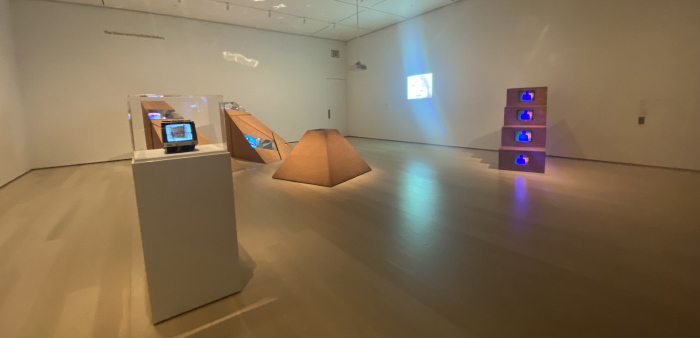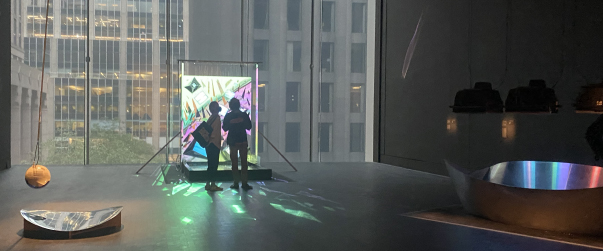Shigeko Kubota’s, Liquid Reality Exhibition, is an immersive viewing of videos using sculptures, essentially destroying the constraints of viewing them through a TV box. Kubota being among the first-generation artists to embrace video, uses different filming techniques and editing to distort how videos should be viewed and how they can corporate nature, technology, and time. While visiting the exhibition, the light room had works of plywood and sheet metal all taking on a structural form of what the videos constituted. Three Mountains, for example, was footage from three different terrains shot by a moving car but installed inside a mountain (pyramid-like) structure and with distorted mirrors and angles. This work along with Duchampiana: Nude Descending a Staircase, utilizes structures to present distorted video footage but this alone combines the creative aspect of having a stand still structure play moving film that evokes time stopping for the person viewing the work. Interestingly, I was more surprised by her first work Berlin Diary: Thanks to My Ancestors, just the use of having handwritten kanji tied on top of the small television with its static background truly invokes the idea that viewing video can be transformed into a creative artistic element.

While the light room exhibition was thoughtful and truly showed the origins of what Kubota portrays, the dark room opposite to it with its similar techniques personally leaves viewers more transfixed. Using mirrors and flowing water creates a stronger aesthetic along with the low illuminated room making the water’s light reflect on the walls and floor. This side of the exhibition had three works starting from the Video Haiku-Hanging Piece which creates a visual representation of a poem from a hanging pendulum ball where the video is reflected from the ball to the mirror on the ground. Only viewers who are present at the time can view the video on the mirror being stretched by the swinging ball. River and Niagara Falls are similar because they depend on the use of water flowing and the videos being mirrored by the water for us to view the video, looking at the flow of the water as it moves in time. Here again we see the relationship of a structure and its video viewing, how both overlay one another to trap us into a fall-sense of moving with the video but standing still through it.
Unfortunately, the dark room was more favorable to the audience at the exhibition rather than the light room and I could understand that most would find the aesthetic structures more intriguing. However, it feels that as we walk through the exhibition starting from the light room to the dark room it connects with one another to showcase the emergence and growth of video visualization in time and creativity using stand-still structures. Sometimes we can find viewing videos to a simple activity and not much work is needed to enjoy what we watch, but when we let go of viewing video constraints, I understand how Shigeko Kubota wanted to create a form of artistic work. While her videos may appear distorted, the simple act of having to be present in time to truly view them being reflected in the structural works and adding nature in her work just makes the footage realistic.
-Yoselin Castelan Ramirez
